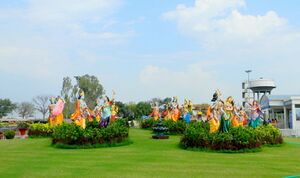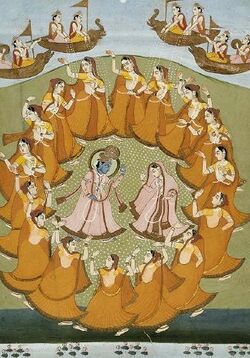Philosophy:Rasa lila
The Rass lila (IAST rāsa-līlā) (Hindi: रास लीला) or Rass dance is part of the traditional story of Krishna described in Hindu scriptures such as the Bhagavata Purana and literature such as the Gita Govinda, where he dances with Radha and her sakhis. The Indian classical dance of Kathak evolved from the 'Raslila of Braj and Manipuri Classical Dance' (Vrindavana) also known as Natwari Nritya, which was revived in 1960s by the Kathak dancer, Uma Sharma.[1]
The term, rasa meaning "aesthetics" and lila meaning "act," "play" or "dance" is a concept from Hinduism, which roughly translates to "play (lila) of aesthetics (rasa)," or more broadly as "Dance of Divine Love".[2]
The rasa lila takes place one night when the Gopis of Vrindavana, upon hearing the sound of Krishna's flute, sneak away from their households and families to the forest to dance with Krishna throughout the night, which Krishna supernaturally stretches to the length of one Night of Brahma, a Hindu unit of time lasting approximately 4.32 billion years. In the Krishna Bhakti traditions, the rasa-lila is considered to be one of the highest and most esoteric of Krishna's pastimes. In these traditions, romantic love between human beings in the material world is seen as merely a diminished, illusionary reflection of the soul’s original, ecstatic spiritual love for Krishna, God, in the spiritual world.
In the Bhagavata Purana it is stated that whoever faithfully hears or describes the Rasa lila attains Krishna's pure loving devotion (Suddha-bhakti).[3]
Just as a child plays at its own will with its reflection in a mirror, even so with the help of His Yogamāyā Bhagavān Śrī Kṛṣṇa sported with the Gopīs, who were like many shadows of His own form.[4]
Etymology
Apart from the definition above, the term also comes from the Sanskrit words rasa and lila, with rasa meaning “juice”, “nectar”, "emotion" or "sweet taste" and lila meaning "act".By taking this etymologic breakdown of the word literally, "Rasa Lila" means the “sweet act” (of Krishna). It is often freely rendered as "the dance of love".
Performance
Rasa lila has been a popular theme in Kathak, Bharatanatyam, Odissi, Meitei, and Kuchipudi items. Rasa Lila is a popular form of folk theatre in the regions of Mathura, Vrindavana in Uttar Pradesh, especially during the festivals of Krishna Janmashtami and Holi, and amongst various followers of Gaudiya Vaishnavism in the region. Raas Leela (Raax Mahotsav) is also observed as one of the State Festivals of Assam which usually is celebrated during Late November or Early December. During Raas Mahotsava, several thousand devotees visit the holy temples and Xatras of Assam every year. The Raas Mahotsav of Majuli, Nalbari and Of Howly deserve a special mention in this regard.
In the tradition of Vaishnavism of Manipur Rasa Lila is depicted within Manipuri classical Indian dance, and revolves around the same story of the love between Krishna and the cowherd girls and tells the divine love story of Krishna, svayam bhagavan and Radha, his divine beloved. This form of dance was started by Bhagya Chandra in 1779 and in some parts of India is still performed every year on Krishna Janmashtami (the festival to celebrate Krishna's birthday). According to different traditions, the rasa-lila is performed either by boys and girls, or by girls only. The dance is performed holding dandi (sticks) and is often accompanied with folk songs and devotional music.
The Traditional Rasa Lila performances in Vrindavan are famous throughout the Vaisnava world as an experience of the spiritual world. Rasa Lila performance was started by Swami Sri Uddhavaghamanda Devacharya in the early 15th Century CE at Vamshivata in Vrindavan, Mathura. He was a prominent saint of the Nimbarka Sampradaya, and disciple of the world-renowned Swami Sri Harivyasa Devacarya. The Vani literature of Vraja is the transcription of the songs that were heard by Swami Harivyasa Devacarya and his Guru, Swami Shri Shribhatta as they meditated on the Nitya Lila of Shri Radha Krishna. These songs describe the eternal spiritual abode of Shri Radha Krishna, the Sakhis and Nitya Vrindavana Dham - or Nikunja Dham.
As many new devotees of that time could not understand the Vraja language, Swami Uddavaghamanda Devacarya trained his Brahmachari students to play the parts that appeared in the songs in order to get a visual representation of the Lila that was being described. Many were sceptical of this, and attempted to thwart the first enactment. However, at the conclusion of the first Rasa Lila, tradition has it, the Lord Himself appeared and gave the actors his own Crown, and decreed that whenever a qualified actor was to take the part of the Lord, from the moment he put on the crown on his head, it should be understood that he represents the Lila potency of God, and treated with due respect. Shri Radha and Krsna shall be known as Shri Radha Rasavihari.
Since then, the traditional form has remained that actors who are young Brahmacharis will join a group led by the Swami of that group. The music remains the typical Dhrupada style of the Vraja Acharyas who penned the songs they heard to the accompaniment of Sitar and Pakhawaj and the songs are sung in Vraja Language, a parent to modern Hindi.
Recently, many people have changed the traditional music to popular music. Yet there are a dedicated few who seek to preserve the traditional form of devotional art known as Rasa Lila.
References and notes
- ↑ Richmond, Farley P.; Darius L. Swann; Phillip B. Zarrilli (1993). Indian theatre: traditions of performance. Motilal Banarsidass Publ.. p. 197. ISBN 81-208-0981-5. https://books.google.com/books?id=3HIh7oPkvAMC&pg=PA198&dq=Uma+Sharma&lr=&cd=12#v=onepage&q=Uma%20Sharma&f=false.
- ↑ Schweig, G.M. (2005). Dance of divine love: The Rasa Lila of Krishna from the Bhagavata Purana, India's classic sacred love story.. Princeton University Press, Princeton, NJ; Oxford. ISBN 0-691-11446-3.
- ↑ Bhag-P 10.33.39
- ↑ Hanumanprasad, Poddar (1941). Gopīs' Love for Śrī Kṛṣṇa. Gorakhpur: Gita Press.
- Music in traditional Indian theatre: special reference to Raas Leela, by Rani Balbir Kaur. Shubhi Publications, 2006. ISBN:978-81-87226-99-4.
Books
- Dance of Divine Love: The Rasa Lila of Krishna from the Bhagavata Purana, India's classic sacred love story, by Graham M. Schweig. Princeton University Press, Princeton, NJ; 2005 (ISBN:0-691-11446-3).
- Rasa - Love Relationships in Transcendence, by Swami B.V. Tripurari (ISBN:978-1-886069-10-7)
- Theatre and Religion on Krishna's Stage, by David Mason, New York: Palgrave, 2009
- "Essays on Indo-Aryan Mythology", by Narayan Aiyangar, 1898 (ISBN:1-104-83270-4) (ISBN:978-1-104-83270-4)
External links




